by Christina MacFarquhar
Residents of Jibei Island, located in the north of the Penghu archipelago, were joined this spring by environmental groups and legislators in a successful attempt to block a Build, Operate and Transfer (BOT) project that could have been devastating to the island’s ecology and small local businesses. In a public hearing held by the Sustainability Forum of the Legislative Yuan on 9 March 2006, demands were made on developers and government agencies to justify the haphazard Environmental Impact Assessment (EIA), the exclusion of local opinion in the decision-making process, and an attempt to whitewash the long-running illegal occupation of land by tourism operators. Yet some of the decisions reached at the meeting seem to have fallen on deaf ears, and pressure is still being exerted on the island to conform to this heavy construction-based pattern of development.
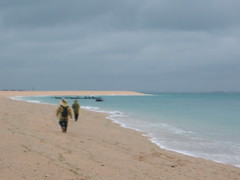
A stormy day on Shawei spit (CM)
Between 300,000 to 400,000 visitors flock to Jibei every summer, generating millions of NT dollars a year for tourism operators on this island of just over 305 hectares. This income would be of great benefit to the island’s population of 1,500, among which increasing numbers of young people are leaving for parts of Taiwan with better job prospects. However, what the majority of tourists come to enjoy is a treasure out of the reach of most residents of Jibei: the golden sands of Shawei beach, extending 700 meters out to sea to the South, and cut off from the rest of Jibei by a surrounding wall to the North, built by the proprietors of Sea Paradise Resort.
Both private and government websites boast of the beauty of this stretch of land, enticing holiday-makers to enjoy the scenery, water sports and the traditional lifestyle for which Jibei is famous. But few tourists come into contact with the local community for long enough to detect the widespread discontentment on the other side of the wall. Tours, as well as the island's infrastructure, are designed to guide those alighting at the harbour directly to and from Shawei, often without even passing through Jibei’s only town. A round-the-island road allows 60-seater buses to crawl round the coast, enabling passengers to view the island and get to the resort, or back to the pier, without moving a muscle. This road was one of Penghu National Scenic Area Administration's (PNSAA) contributions towards what it views as the development of 'local tourism'. Yet for the last two decades, locals wishing to follow the buses as they turn into the Sea Paradise resort have had to stop at the wall, like everyone else, and pay an entrance fee.
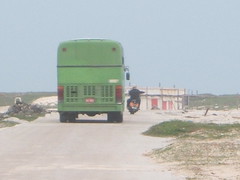
Convenient transport - but where did the beach go?
“Why should I pay to walk on Shawei beach? Jibei Island is my home!” laments Mr. Jhuang, one local who is actively involved in trying to win Jibei’s prime tourist destination back from the businesses that have occupied it since 1983. The dispute came to a head in recent years after the PNSAA announced its plan to invite more private businesses to the island to develop and operate a major expansion of the resort facilities, disregarding the fact that the majority of the 18 hectares used by Sea Paradise was appropriated illegally.
In a 1998 lawsuit, Kaohsiung High Court found the lessee, Mr. Chen Si-nan, guilty of illegally occupying 16.8 hectares of government land, having only received permission in 1983 to use 1.2 hectares for construction of a few simple facilities: a washroom, a break room, a changing room and a restaurant. By subsequently enclosing and developing the remainder of this tourism gold mine, owners of Sea Paradise succeeded in turning profits of about NTD10 million a year as the percentage of Penghu-bound tourists traveling to Jibei rose to over 74 percent, while small local tourism enterprises struggled to compete.
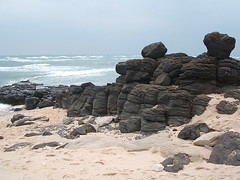
Basalt formations, Jibei (CM)
Despite this blatant disregard for the terms of the lease agreement, 15 years passed without a word form the government agency responsible for overseeing the rent of public land on the island – the National Property Bureau (NPB). Furthermore, following the 1998 High Court ruling, which included an order to demolish all unlicensed buildings at the resort, the Bureau continued to rent the legitimate 1.2 hectares to Sea Paradise, and to turn a blind eye as illegal operations continued on the rest of Shawei beach.
At the public hearing held on 9 March 2006, the NPB admitted to having made an administrative error by failing to challenge Mr. Chen’s use of the land, but claimed to have responded to the 1998 ruling by pursuing rent in arrears for the illegally occupied area, and denied responsibility for managing the demolition of unlicensed buildings. This met with a series of challenges from the convener of the Forum, Li Gen-jheng, who questioned the NPB's decision to continue the lease, while pursuing an amount of money (a mere NT$1000 per hectare per year) vastly disproportionate to the profits made by the resort, allowing the proprietors to go completely unpunished. Indeed, as argued by the Forum’s chairman, Legislator Tian Ciou-jin, rather than the proprietors being penalized for breaking the law, they were instead being rewarded with a 50-year BOT project on the disputed land and NT$38 million in subsidies, all courtesy of the PNSAA.
According to the PNSAA's bidding manual, the BOT project aims to turn Jibei Island into a major harbour and holiday center, promoting tourism and stimulating local employment and prosperity. Yet there is no mention of local participation in the design and implementation of the development. Bidding companies are merely required to be a corporate person legally established in Taiwan with experience in running facilities of a similar budget size or floor space, and there is no limit on the proportion of foreign shareholders.
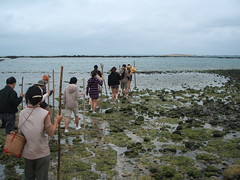
Tour of old fishing routes with Mr Jhuang (CM)
Not only does this project threaten to exclude locals and squeeze out smaller tourism enterprises, it would also steer development on Jibei further in the direction of the water-sports theme promoted by proprietors at Shawei beach, rather than the culture and ecology-based tourism that many would like to see share the focus of tourism on the island. The sea surrounding Jibei is host to the world's most northerly reefs of Turbinaria mesenterina coral, as well as the pitch-black basalt that characterizes much of Penghu’s geological make-up. It also boasts a several hundred-year-old tradition of the use of stone tidal weirs (石滬) for catching fish. These curved walls of basalt and coral, hand-built over periods of up to ten years, are submerged at high tide, and form a trap for sea creatures when the tide recedes. The weirs can also be seen in other parts of Penghu, where they have contributed to supporting livelihoods under what are often extremely harsh living conditions, particularly during the long spell of strong winds between October and April each year.
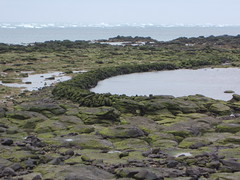
Stone Tidal Weir, Jibei (CM)
Locals such as Mr Jhuang would like to continue to share with tourists these features, as well as their knowledge of Jibei’s cultural heritage, and environmental groups and scholars such as Professor Chen Yu-feng of the Department of Ecology at Providence University have suggested preserving the area as an international base for environmental studies. Those interested in preserving or restoring some of the natural features of Jibei would do well to act quickly on such advice; due to years of purely profit-oriented operations on Shawei (also including gravel extraction), and thanks to the Administration and its visions of cement-based tourism, the ecology and beauty of the coastline are now marred by litter dropped or washed up on the beach, and by wave breakers, roads and concrete pagodas reminiscent of the more heavily sculpted parts of Taiwan proper. These "facilities" came as part of the Administration’s preparatory work for the BOT project, which also includes plans for government-funded car parks and a desalinization plant.
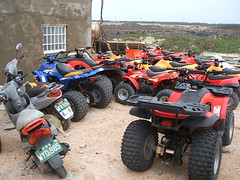
Recreational vehicles suspected of damaging Shawei beach (CM)
In recent years, the fine sand of Shawei beach has also seen an accumulation of dead coral, as well as estimated erosion of the spit itself of up to 200m lengthways, and the disappearance of fish and other marine wildlife. It has been difficult to pinpoint the exact source of the damage, but it is believed that irresponsible diving practices, the use of recreational sand vehicles, the alteration of wind and wave flow patterns through construction of obstacles such as sea walls, and modern fishing techniques have all contributed to these phenomena.
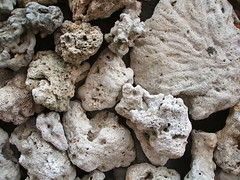
Coral graveyard, Jibei (CM)
Although damage caused by fishing cannot be attributed to tourism on Shawei, this does highlight the vulnerability of Jibei’s marine ecology. Penghu has seen a dramatic decline in sea life populations since the 50s, when explosives and electrocution were introduced into fishing and fleets enlarged. Dragnet fishing by the Chinese is also blamed for draining fish populations and damaging coral reefs. Under these circumstances, can further exposure of these fragile eco-systems to the consumption and pollution of hoards of holiday-makers be justified?
In addition to pollution and other sources of damage to the environment, of immediate concern to residents of Jibei is the over-extraction of ground water, which may be sufficient for the island’s small population, but cannot sustain the thousands of people staying at Shawei each year. Subsidence has occurred, and drinking water is now contaminated with seawater, forcing residents to control salt levels by alternating between and mixing water from the six official wells. Some water is even shipped from other parts of Taiwan, which, considering the pressing water crisis faced by the whole nation, cannot be considered a long-term solution. The idea of constructing large desalinization facilities is also an extension of the trend in resource mismanagement perpetuated by many government agencies in Taiwan; pushing capacity to the limits rather than increasing efficiency, and no talk of caps on consumption.
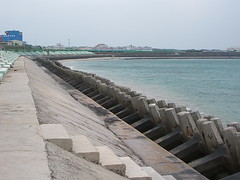
Former beach with wave breakers, Jibei (CM)
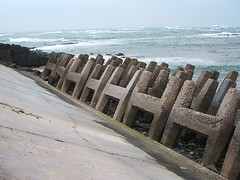
Wave breakers (CM)
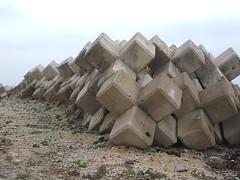
Wave breakers (CM)
Issues raised at the public hearing revealed that the PNSAA had placed little emphasis on the Environmental Impact Assessment (EIA) for the BOT project. For example, it was shown that coordinates for coral reefs cited in the EIA report were false, some even indicating coral reefs located on what was actually dry land. The PNSAA also violated procedure by privately allowing proprietors to sidestep their duty to produce an independent environmental impact report.
Also, review meetings for the project had been held behind closed doors, hindering as far as possible the participation of those residents of Jibei not in favor of the proposed development. At the public hearing, the Public Construction Committee (PCC ) defended this procedure, citing the Law for Promotion of Private Participation in Infrastructure Projects (促參法), which calls for secrecy regarding information provided by the review applicant. On this matter, however, the Forum concluded that since the Law requires all parts of the review process except the applicant’s details to be made public, residents of Jibei should have access to all other details of the review procedure, including the minutes of meetings. In addition, Legislator Lin Shu-fen announced her plan to propose an amendment to the Law to include a public hearing system in the BOT review procedure. From the perspective of affected communities and environmental groups, such changes cannot not come soon enough; any progress in persuading government agencies to commit to freedom of information in all EIA and construction projects could have significant effects on resource management and the direction of development in Taiwan.
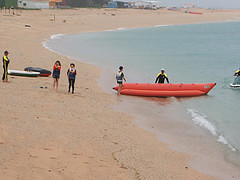
15 April 2006: Business as usual on Shawei beach
But there are, of course, those who would rather not sit around too long waiting for Jibei’s residents to gain control of the situation. Since the hearing, illegal tourism operations have continued on Shawei beach, albeit in a somewhat more subtle fashion (tourists are known to have been shipped out of sight when proprietors get wind that anti-BOT groups are converging on Jibei Island). Deadlines set by the Forum in March have come and gone, while the unlicensed buildings remain, and there is still much tension in the air between those for and against the project.
At a meeting held on Jibei on 15 April 2006, one Penghu official argued that Jibei urgently needs to make its mind up about how to expand its tourism industry, emphatically repeating the question, “Is Jibei ready or not?”
Ready for what? one wonders. To sell its soul to those who claim to have Jibei’s best interests at heart, only to be asphyxiated under a smooth, expensive layer of cement? The island, at least, will surely never be ready for that. It remains to be seen whether the people can spare it that fate.